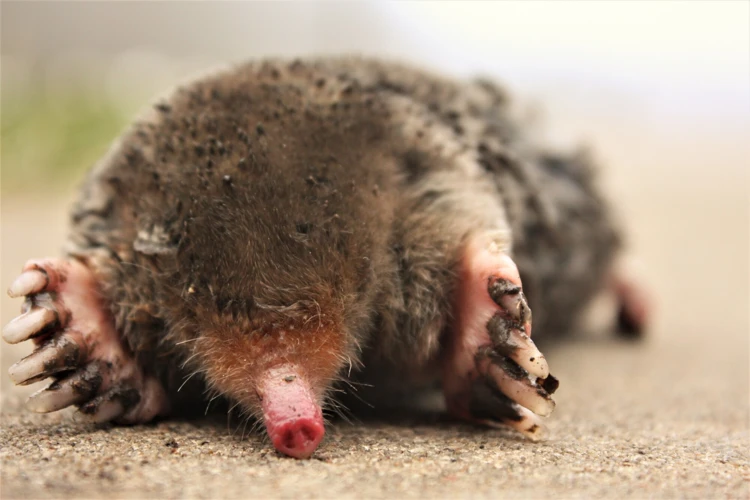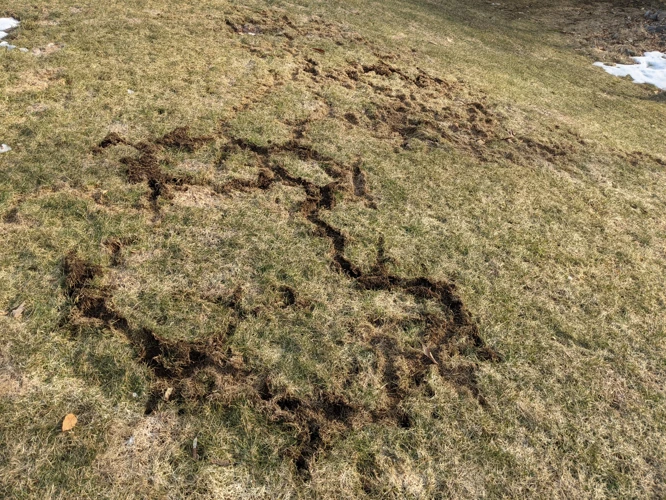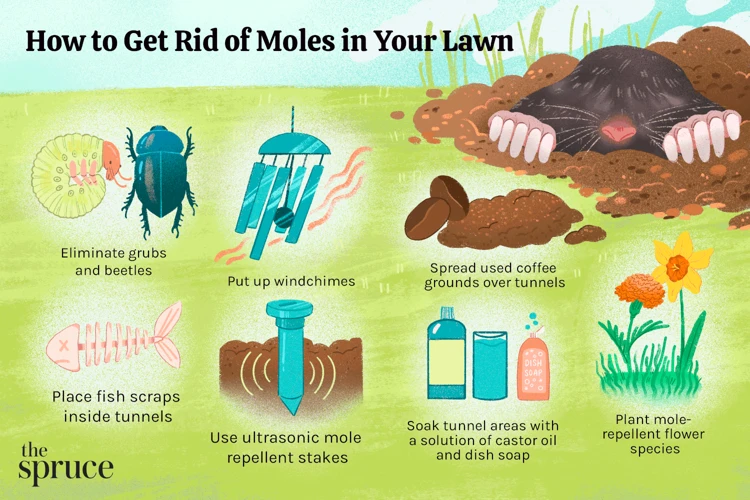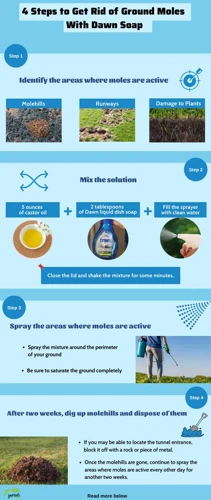Introduction

Understanding the behavior of moles and finding ways to control their migration can be a perplexing challenge for many property owners. Moles, often considered pests due to their ability to cause extensive damage to lawns and gardens, have a unique set of characteristics that enable them to migrate from one location to another. In this article, we will explore the reasons why moles migrate and discuss effective ways to stop their migration while also outlining preventive measures to keep them away.
Understanding mole migration
To effectively prevent mole migration, it is important to understand why moles migrate in the first place. Here are some possible factors that trigger mole migration:
| Lack of food source | Overpopulation | Climate change and weather patterns | Drought and flooding |
|---|---|---|---|
| When moles cannot find their preferred food, such as earthworms, grubs, and insects, in their current habitat, they may move to other locations to look for better food sources. | Moles reproduce rapidly and a high density of moles in an area may result in increased competition for resources, leading to migration. | Moles are sensitive to changes in temperature, humidity, and other environmental factors. Extreme weather events or long-term climate changes may force moles to relocate to more suitable habitats. | Severe drought or flooding can disturb the soil structure and reduce the availability of food for moles, causing them to migrate to other areas with more favorable conditions. |
Understanding these factors can help homeowners identify the reasons why moles are migrating in their yard, and take appropriate measures to address the issue. By implementing strategies to address the root causes of mole migration, homeowners can reduce the likelihood of dealing with mole damage and enjoy a pest-free lawn. To learn more about how to prevent mole migration, check out our article on preventing moles from migrating in your yard.
Why do moles migrate

As gardeners and lawn enthusiasts, it is important to understand the reasons behind the migration patterns of moles in order to effectively control and prevent damage to our beloved green spaces. There are several factors that trigger moles to migrate, such as soil type, overpopulation, climate change, and natural disasters like drought and flooding. In this section, we will delve deeper into these reasons and discuss their potential impact on your lawn.
Lack of food source
Moles are known for their burrowing and digging habits, which can cause severe damage to lawns and gardens. Moles migrate for several reasons, one of which is the lack of food source. Moles primarily feed on earthworms, insects, and other small invertebrates found in soil. When the food source is scarce or depleted, moles may look for other locations where the food is plentiful.
During periods of hot and dry weather, the soil becomes hard and compacted, making it difficult for earthworms and insects to move around. This lack of moisture and nutrients leads to a decrease in the food population, which in turn triggers moles to migrate to another location where the food is abundant.
Another reason why moles may migrate due to the lack of food source is overfeeding. Moles can deplete an area of worms and insects, rendering the area unsuitable for further feeding. This overpopulation of moles alongside the depletion of food resources leads to stiff competition for food, forcing moles to migrate to other regions in search of food.
Changes in the habitat around the moles can lead to a decrease in the food population, resulting in their migration. The use of chemical products such as pesticides and herbicides can kill earthworms and other beneficial organisms that moles feed on, causing a decrease in the mole’s food source. Additionally, the habitat around the mole’s breeding grounds can become unsuitable for the growth of earthworms, leading to migration in search of food.
Moles also migrate seasonally to escape harsh weather conditions like cold and snow. They may move from the soil surface to deeper territories to find a more suitable location. In contrast, during spring and summer, they may migrate upwards to take advantage of the moister soil surface and an increase in insect populations.
Understanding the science behind mole migration is essential in preventing mole populations from decimating your garden or lawn. It is necessary to recognize the signs of mole activity and take sound preventive measures. If the damage becomes overwhelming, professionals should be consulted to help control mole populations. For more information on the science behind mole navigation and migration, check out this informative article on moles navigation and migration science.
Overpopulation
Overpopulation of moles can also trigger migration. Moles can reproduce quickly, and a single mole can give birth to four to six pups at a time. Without any natural predators, this can result in an ever-increasing mole population. When the number of moles becomes too high for the available space, they will migrate to find new sources of food and territory.
This overpopulation can be caused by several factors:
- The lack of natural predators in the area;
- The abundance of food sources available;
- The high survival rate of mole pups;
- Other factors that can contribute to increased mole population.
When moles overpopulate, it can cause significant damage to your lawn, garden or crops in search of food. The damage may include molehills, burrowing under the soil causing holes, and uprooted plants. It is essential to take action immediately to prevent further damage to your lawn or garden.
One effective way to control the population of moles is by trapping them. Live traps are humane, and the moles can then be released in a remote area far from your lawn or garden. Additionally, mole repellents such as castor oil, mothballs, and ultrasonic devices can also help to keep moles away from your property.
It is important to note that trapping or repelling moles can be labor-intensive and require expertise. It is recommended to contact a professional mole removal service to handle the mol removal if you are not familiar with mole control techniques.
To prevent moles’ overpopulation, it is crucial to control the population size and food source available for these animals. Landowners should establish preventive measures such as reducing watering in gardens and lawns since a moist environment invites earthworms and grubs which are part of the mole diet.
For more information on moles’ migration, take a look at our moles’ migration article or understanding moles’ migration patterns article.
Climate change and weather patterns
Climate change and weather patterns can also trigger mole migration. Climate change affects weather patterns, temperature, precipitation and the overall climate in certain areas. This can have a significant impact on the ecosystem, causing moles to migrate in search of a suitable habitat. For instance, if the climate becomes drier or unusually hot, moles may be forced to move to cooler and wetter areas. Factors like excess rain or drought could also affect the moisture content of the soil or damage food sources, making it difficult for moles to survive in that environment. As a result, mole migration due to climate change and weather patterns is something that can hardly be controlled or prevented, since it has a lot to do with natural factors beyond our control. However, mole control experts suggest that being more environmentally conscious and reducing our carbon footprint can help mitigate the negative effects of climate change and slow down mole migration to some extent.
| Pros | Cons |
|---|---|
| Helps ecosystems adapt to changing climate | May lead to loss of biodiversity |
| Can help identify areas most vulnerable to climate change | Requires significant research and resources |
| Can inform policy decisions on mitigating climate change | May prompt unexpected consequences or uncertainties |
Although mole migration due to climate change and weather patterns is beyond our control, we should still keep an eye on the overall climate trends and the implications it has on wildlife. Scientists and researchers are using advanced technology to track and study mole migration patterns and find ways to mitigate the harmful effects of climate change on their habitat. To learn more about the benefits and drawbacks of mole migration, check out our detailed guide here (source).
Drought and flooding
During periods of drought or flooding, moles may find themselves without the food and shelter they need. When there is a severe lack of moisture, earthworms retreat deep into the soil, and other insects may die off, which means moles need to travel farther to find sustenance. On the other hand, when there are heavy rains, mole tunnels can become flooded, and the creatures are forced to seek drier ground or risk drowning.
In both cases, moles may migrate to new areas in search of better lairs and food sources. These natural disasters can contribute to increased mole activity in areas where they might not be typically present. If you are dealing with a sudden influx of moles due to drought, flooding, or other environmental factors, then it is essential to promptly implement measures to prevent them from damaging your lawn. To learn more about moles’ seasonal migration, refer to our Moles’ Migration Guide. If you want to discover the difference between mole migration and hibernation, please visit our Mole Migration vs Hibernation article. If you want to learn more modern ways of mole tracking, we suggest reading out Mole Tracking Tech article.
Signs of mole activity

Moles can sometimes be difficult to spot, but there are some signs to look out for to determine if they are active in your lawn or garden. The most obvious sign is the presence of molehills, which are mounds of soil that the moles push up as they dig. These molehills are often circular and can vary in size from a few centimeters to a foot in diameter.
Another sign of mole activity is the presence of raised ridges or tunnels on the surface of the ground. These ridges are created by the moles as they dig their tunnels just below the surface of the soil. The tunnels can extend down several feet, and are often used by the moles to travel between feeding and nesting areas.
Moles are also known for their voracious appetite for worms and beetles, so if you notice a decline in the number of these insects in your lawn or garden, it could be a sign of mole activity. The moles may also cause damage to plant roots as they dig tunnels, which can affect the overall health of your plants.
If you are unsure if you have a mole problem, try placing a small amount of flour or talcum powder on the soil surface near a suspected molehill or raised ridge. Check back later to see if the powder has been disturbed, which would indicate mole activity.
It’s important to note that although voles and field mice may create similar-looking tunnels and mounds, they are not the same as moles and require different control methods. If you’re not sure what type of pest you’re dealing with, it’s best to consult a professional.
Harmful effects of moles on your lawn

Moles are adorable burrowing creatures that can wreak havoc on your lawn and garden. These animals are known for their digging and tunneling habits, which can lead to unsightly and uneven terrain that not only diminishes the aesthetic value of your property but also poses a safety risk to those who walk on it. The subterranean tunnels created by these creatures also increase the chances of tripping, falling, and getting injured.
Moles are insectivores that feed on grubs and earthworms found beneath the soil. While they help control the insect population on your lawn, their feeding habits can also be detrimental to the health of your grass and plants. The constant burrowing and tunneling disrupt the root system of your vegetation, leading to wilting and death. This damage can weaken your lawn’s structural integrity, and make it more susceptible to other environmental stresses such as drought and extreme temperatures.
Moles also contribute to soil erosion, as their tunnels create channels that allow water to run off more quickly. This can lead to additional problems such as localized flooding, soil compaction, and nutrient depletion in your soil. All of these issues can make it more challenging to maintain a healthy and thriving lawn or garden.
Another concern is that moles can attract other pests such as voles and shrews that may further damage your lawn and garden. These animals use the mole tunnels as highways to move around and find food, rendering your property an attractive destination for a host of garden pests.
It is essential to take steps to prevent or address mole activity early on to reduce the potential harm that they can inflict. By doing so, you can enjoy a beautiful and healthy lawn without worrying about the harmful effects of these adorable yet destructive animals.
Effective ways to stop mole migration

As mole migration can cause significant damage to your lawn and garden, it’s important to understand the most effective ways to stop it. There are several solutions available, from using barriers to trapping and relocating moles. It’s crucial to choose the best approach for your situation, and to implement other preventive measures to keep moles away in the future. Let’s explore some of these solutions in more detail below.
Using barriers
One effective way to stop mole migration is by using barriers. Barriers are physical obstructions that prevent moles from tunneling into certain areas. Here are some types of barriers that you can use:
- Burying chicken wire: This is a cost-effective solution that involves burying chicken wire at least 2 feet deep around the perimeter of your lawn or garden. The sharp edges of the wire discourage moles from burrowing through it.
- Installing underground fencing: This method involves installing a fence made of PVC or polypropylene underground around your lawn or garden. This is a more expensive solution but is more durable and can last for many years.
- Planting bulbs with mesh: This is a natural solution that involves placing mesh or wire around bulbs before planting them. As the bulbs grow and spread, the mesh will act as a barrier and prevent moles from burrowing.
It is important to note that these barriers should be installed before any signs of mole activity are detected. If moles have already tunnelled into your lawn, they may simply burrow underneath the barrier. Barriers should be used in conjunction with other methods, such as repellents and trapping. By using a multi-pronged approach, you can effectively stop mole migration and protect your lawn or garden from damage.
Applying repellents and natural remedies
Using repellents and natural remedies is another effective way to stop mole migration. Here are some options for homeowners to consider:
- Castor oil: Castor oil has been used for years to repel moles from lawns. This oil is made from the seeds of the castor plant and is safe for pets and humans. When applied to a lawn, castor oil produces an odor that moles find unpleasant, causing them to leave the area.
- Peppermint oil: Peppermint oil is another natural remedy that can be used to repel moles. This oil has a strong scent that moles are not fond of, so applying it to a lawn can help keep them away.
- Garlic: Garlic can be used in several forms to repel moles. Some homeowners plant garlic bulbs around their lawn, while others create a garlic spray to apply to their yard. The strong odor of garlic can discourage moles from inhabiting the area.
- Ultrasonic devices: Some homeowners have found success using ultrasonic devices to repel moles. These devices emit a high-frequency sound that is unpleasant to moles, causing them to leave the area. However, some research suggests that ultrasonic devices may not be effective in repelling moles.
- DIY repellent sprays: There are several DIY repellent sprays that homeowners can make to repel moles. One popular recipe includes mixing castor oil, dish soap, and water in a spray bottle. Applying this mixture to a lawn can help deter moles.
It’s important to note that while these repellents and remedies can be effective, they may not work for every situation. Additionally, some of these remedies may require regular reapplication to maintain their effectiveness. It’s essential to research and choose a repellent that works for your specific situation to effectively stop mole migration.
Trapping and relocating moles
One of the most effective ways to deal with a mole infestation is through trapping and relocating them. However, it’s important to note that this method should only be done by someone who is experienced and knowledgeable about moles and their behavior.
Here are the steps to trap and relocate moles:
- Choose the right type of trap: There are various types of traps available, but the most commonly used ones are the scissor-jaw, harpoon and choker-loop traps. Make sure to select the type that works best for your situation and is humane.
- Identify the active mole tunnels: Look for raised ridges and mounds of soil on your lawn to identify the active mole tunnels. These are the areas where you should set your traps.
- Set the trap: Place the trap in the active tunnel and make sure to set it according to the manufacturer’s instructions. Cover the trap with a board or a bucket to prevent any light from entering the tunnel, which could cause the mole to avoid the trap.
- Check the trap regularly: It’s important to check the trap at least once a day to see if it has caught a mole. If it has, carefully remove the mole and relocate it to an area that’s at least five miles away from your property.
- Repeat the process: Set the traps in other active tunnels and repeat the process until you have trapped all the moles on your property.
Keep in mind: Trapping and relocating moles can be an effective method, but there is a risk of injury to both the mole and the person doing the trapping. Also, if the underlying issue causing the mole migration is not addressed, new moles may move in and take their place. It’s important to consider all options and consult a professional if needed.
Contacting a professional mole removal service
When other methods fail, the best course of action could be to contact a professional mole removal service. These services specialize in the humane removal and relocation of moles in a way that doesn’t harm them or damage your lawn.
Before hiring a professional mole removal service, it’s essential to do your research and ensure that the company is reputable and uses humane methods. Here are some factors to consider when choosing a professional mole removal service:
| Factors to Consider | Explanation |
|---|---|
| Experience | Choose a company with experience in mole removal to ensure they are knowledgeable and skilled in handling the issue. |
| Methods used | Ask the company about the methods they use to remove moles. Make sure they prioritize humane methods that don’t harm wildlife. |
| Costs | Get a quote from the company before hiring them to ensure the costs are within your budget. Avoid companies that charge unrealistically low rates, as they may not be reliable or use effective methods. |
| Reviews | Research the company’s reputation by reading reviews and testimonials from previous customers online. This can help you get an idea of the quality of their work and their customer service. |
| Guarantees and warranties | Choose a company that offers a guarantee or warranty on their services to ensure that you are satisfied with the work and that the mole problem is resolved. |
Once you have selected a professional mole removal service, they can provide you with customized solutions based on your lawn’s specific needs. They may use a combination of trapping, repellents, and other methods to eliminate the mole problem and prevent future infestations.
It’s important to note that professional mole removal services can be costly, and preventive measures can help reduce the likelihood of needing their services in the future. Consider implementing preventative measures, such as using barriers or natural remedies, to keep moles at bay and avoid future mole infestations.
Preventive measures to keep moles away

To prevent moles from invading your lawn, there are several preventive measures you can take. One of the most effective steps is to keep your lawn well-maintained. Moles are attracted to yards that are overgrown, so regularly mowing your lawn and keeping it trimmed can help discourage them from setting up camp.
Another preventative measure is to eliminate their food source. Moles feed on earthworms and other insects, so treating your lawn with insecticides or other pest control methods can help reduce their food source.
You can also create barriers around your yard to prevent moles from entering. Planting mole-repelling plants like daffodils, marigolds, and alliums around the edge of your lawn can help deter moles from entering. Another barrier option is to install a physical barrier like a mesh fence or edging around your lawn.
It’s important to monitor water sources in your yard as well, as moles are attracted to moist soil. Fixing leaky irrigation systems and draining standing water can help reduce the likelihood of attracting moles.
Finally, if you have had issues with moles in the past or live in an area with a high mole population, regularly checking your lawn for signs of mole activity can help you quickly identify and address any potential issues before they become major problems. By implementing these preventive measures, you can significantly reduce the likelihood of moles migrating to your lawn in the future.
Mole control do’s and don’ts
It’s important to know what to do and what not to do when it comes to controlling moles. Here are some crucial tips to keep in mind:
Do:
- Inspect your lawn regularly for signs of mole activity.
- Address overwatering or poor drainage issues that can create a prime habitat for moles.
- Use barriers and repellents as a deterrent.
- Be mindful of any new landscaping or construction projects that may disturb the soil and attract moles.
- Take preventive measures, such as removing grubs and other insects that moles feed on.
- Consider contacting a professional mole removal service if you have a serious infestation.
Don’t:
- Use poisonous baits or devices that could harm non-target animals, pets, or children.
- Ignore signs of mole activity and let the problem persist.
- Attempt to handle or capture moles yourself, as they may bite or transmit diseases.
- Use ineffective home remedies, such as flooding tunnels or playing loud sounds, that will not deter moles.
- Install sharp objects or barbed wire around your lawn, which can cause injury to animals.
Remember, it’s essential to take proper measures to control moles without causing harm to them or other animals. By following these simple do’s and don’ts, you can effectively prevent mole damage to your lawn and ensure the safety of your family and pets.
Conclusion
In conclusion, dealing with a mole infestation can be a frustrating and time-consuming task. However, understanding why moles migrate and the signs of their activity on your lawn is crucial in preventing and controlling their presence. It is important to keep in mind that moles play an important role in the ecosystem and eliminating them completely may have unintended consequences.
There are several effective ways to stop mole migration, including using barriers, applying repellents and natural remedies, trapping and relocating, or contacting a professional mole removal service. It is important to follow mole control do’s and don’ts in order to prevent harm to both the moles and your lawn.
Additionally, taking preventative measures such as maintaining a healthy lawn and discouraging the presence of their food sources can help keep moles away.
Overall, mole control requires patience and persistence, but with the right knowledge and techniques, it is possible to effectively manage their presence in your yard.
Frequently Asked Questions
How do I know if moles are migrating on my lawn?
You can identify mole activity by looking for raised ridges and tunnels in the lawn or garden. You may also find piles of dirt or molehills on the surface of the ground.
What causes moles to migrate?
Moles migrate due to a lack of food, overpopulation, climate change, weather patterns, drought, and flooding.
What are the harmful effects of moles on the lawn?
Moles can cause damage to the grass and plants roots, as well as create tripping hazards for people walking on the lawn.
What are some effective ways to stop mole migration?
There are many ways to stop mole migration, including using barriers, applying repellents and natural remedies, trapping and relocating moles, and contacting a professional mole removal service.
How can I prevent moles from migrating to my lawn?
You can prevent moles from migrating by regularly mowing the lawn, removing debris and weeds, and keeping the soil moist and fertile.
What are the best natural remedies to deter moles?
Natural remedies like castor oil and garlic are known to repel moles effectively. Adding elements like wood ash, cayenne pepper, or coffee grounds to the soil can also help deter them.
What types of barriers can I use to prevent mole migration?
Barriers like mesh or hardware cloth can be utilized to prevent moles from entering specific areas like around garden beds or under sheds.
How can I properly trap and relocate moles?
Trapping moles requires patience and the right tools. You can use trigger traps or harpoon traps to capture moles, and then relocate them at least five miles away from your property.
What should I avoid doing to control mole migration?
Avoid using toxic chemicals or poisons to control mole migration, as they can harm other animals and pets in the area. Also, avoid flooding or drowning moles, which can be inhumane and illegal in some areas.
When should I hire a professional mole removal service?
You should contact a professional mole removal service if you have tried various methods to deter moles, but they still persist. Additionally, if you are uncomfortable handling traps or want a humane solution, a professional service can help.







